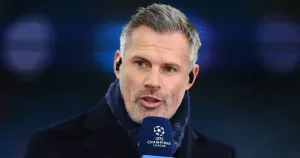Jamie Carragher has suggested Arsenal still trail Liverpool and Chelsea when it comes to selling players, arguing that the Gunners’ transfer model places heavier pressure on Mikel Arteta to turn big spending into major trophies.
Arsenal’s heavy summer — and the net spend problem
Arsenal’s recruitment drive was emphatic, with headline arrivals such as Kepa Arrizabalaga, Martin Zubimendi, Christian Nørgaard, Noni Madueke, Cristhian Mosquera, Viktor Gyökeres and Eberechi Eze, plus Piero Hincapié on loan. The outlay strengthened key areas and deepened the squad — but it also widened the gap between gross spend and sales.
That’s Carragher’s central gripe: Arsenal haven’t consistently monetised squad players. With only a handful of permanent exits (for example, Nuno Tavares and Marquinhos) and the club’s record sale still Alex Oxlade-Chamberlain to Liverpool in 2017, Arsenal again posted one of the league’s heftiest net spends. In an era shaped by PSR and tighter accounting, failing to bring in fees can become as defining as the signings themselves.
Why Arsenal struggle to sell (and why it matters)
There are structural reasons this has been difficult:
- Contract runway & timing. Arsenal have let value erode by holding players too long or allowing deals to run down, narrowing the market and leverage.
- Wage-to-market mismatch. When a player’s wages outstrip their on-pitch value for mid-table buyers, loans and mutual terminations become likelier than profitable sales.
- Role clarity. Fringe players who’ve had limited minutes are harder to market; buyers pay for proof, not potential.
- Risk appetite. Arsenal’s recent priority has been building a title-level core — understandable, but it often means postponing hard calls on saleable assets.
The knock-on effects are clear: fewer profits on disposals, less flexibility the following window, and greater pressure to “make the football justify the finances”.
Chelsea sold £314m worth of players this summer 😱
— Football on TNT Sports (@footballontnt) September 2, 2025
No club has ever made more from sales in a single transfer window 💰 pic.twitter.com/Jsen1z3YGw
How Chelsea turned selling into a competitive advantage
Chelsea have been one of Europe’s most efficient sellers over the last few years, and it hasn’t happened by accident. They built a repeatable process that consistently converts squad depth into cash while staying competitive:
- Homegrown profit engine: Academy players (Mount, Tomori, Abraham, Livramento, etc.) were sold for sizeable fees that count as near-pure profit under PSR rules. That gives Chelsea more room to invest without breaching regulations.
- Early decision points: The club has been ruthless about renewing or selling with two years left on a deal. Clear calls—rather than last-minute fire sales—protect value.
- Loan-to-sell pathways: Strategic loans put players in shop-window roles (regular minutes, correct league), then convert to permanent exits with options, obligations, or sell-ons attached.
- Market mapping: Chelsea identify buyers before they need them—Serie A for centre-backs/forwards, Bundesliga for young talent, even the Saudi Pro League spike for senior pros—so there’s a ready market when they choose to move players on.
- Smart clauses: Buy-backs and sell-ons keep upside on players who might explode later. Even when they sell, they don’t fully walk away from future value.
- Narrative and timing: Exits often follow strong seasons, international tournaments, or prominent loans. The club “packages” a player’s strengths so buyers pay for proof, not potential.
Chelsea have regularly raised significant money from outgoings across multiple windows, softening their net spend and keeping squad refreshes rolling. It’s the consistency that stands out—year after year, they create a market for non-core players and extract value early, rather than letting contracts wind down.



